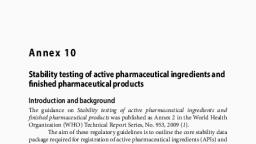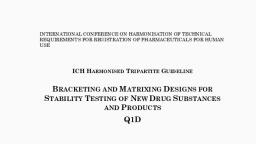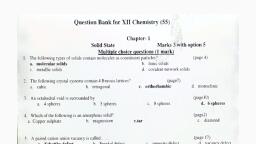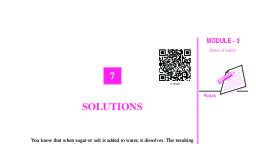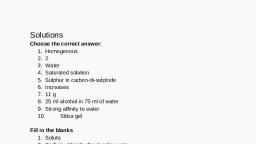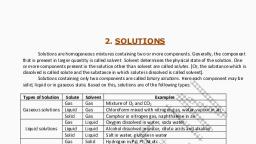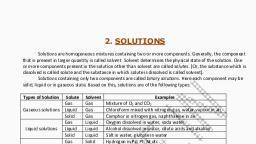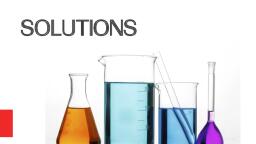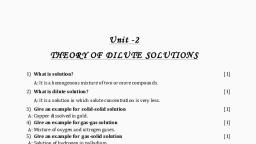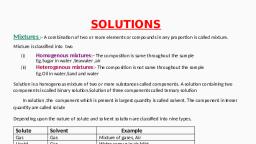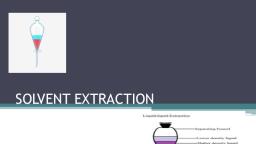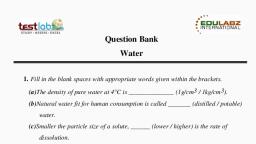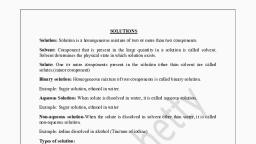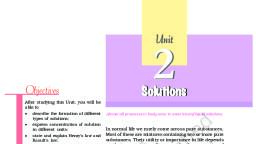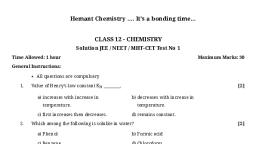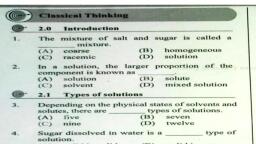Page 1 :
1, SOLUBILITY OF DRUGS, BP302T. PHYSICAL PHARMACEUTICS-I, UNIT-1, SOLUBILITY OF DRUGS, SOLUTION, It is mixture of components which are physically and chemically homogeneous., SOLUTE, The components which are present in the solution is called as solute that dissolves in solvent., SOLVENT, The medium in which components are dissolved is known as solvent., SOLUBILITY, The ability of substance to dissolve in a solvent is called solubility., SATURATED SOLUTION, The solution containing maximum number of solute at a constant temperature is called, saturated solution., SUPER SATURATED SOLUTION, A solution that contains more of the dissolved material then could be dissolved by the, solvent under normal circumstances., UNSATURATED SOLUTION, A solution where the solute concentration is lower than its equilibrium solubility., SOLUBILITY EXPRESSION, Table-1: No. of parts of solvent requires to dissolve 1 part of the solute., Terms, Very soluble, Freely soluble, Soluble, Sparingly Soluble, Slightly Soluble, Very slightly soluble, Practically insoluble, , Parts of solvent required to dissolve one, part of solute, Less than 1 part., 1 to 10 parts., 10 to 30 parts., 30 to 100 parts., 100 to 1000 parts., 1000 to 10000 parts., More than 10000 parts., , Surya Narayan Ratha Adhikari, Asst. Prof., Seemanta Institute of, Pharmaceutical Sciences, Jharpokharia, Mayurbhanj, Odisha, India.
Page 2 :
2, SOLUBILITY OF DRUGS, PERCENTAGE TERM USED IN SOLUBILITY, , 1. % W/W =, solution., , Percent Weight by Weight → No. of gram of solute dissolved in 100 gram of, , 2. % V/V = Percent volume by volume → No. of gram of solute dissolved in 100 gram of, solution., 3. % W/V =, solution., , Percent Weight by volume → No. of gram of solute dissolved in 100 ml of, , MOLARITY, It is defined as the number of moles (or gram molecular weight) of solute dissolved in 1, litre of solution., MOLALITY, It is defined as thmoles of solute dissolved in 1000 g of solvent., SOLUBILITY OF GASES IN LIQUID, The concentration of dissolved gas when it is in equilibrium with some of the pure gas above, the solution is called solubility of gases in liquid., Ex :-- CO2 in Water , or nitrogen as propellent in an aerosol., FACTORS AFFECTING SOLUBILITY, 1. Pressure :--The effect of pressure on the gas is given by Henry’s law, which states that in a very dilute, solution at constant temperature the concentration of dissolved gas is directly Proportional to the, partial pressure of gas above the solution at equilibrium., According to Herry,s law ,, C = 𝜎P, Where, C = Concentration of gas, 𝜎 = Solubility of Co- efficient, P = Partial pressure, Solubility of gases increase with increase in pressure of the gas in the, solution. Ex : O2 , N2 show this type of behavior as lightly soluble., , Surya Narayan Ratha Adhikari, Asst. Prof., Seemanta Institute of, Pharmaceutical Sciences, Jharpokharia, Mayurbhanj, Odisha, India.
Page 3 :
3, SOLUBILITY OF DRUGS, Significance henry’s law:, With increase in pressure solubility increases., 2. Temperature :-Increase the temperature so, Increase the solubility of gas in liquid because the tendency of, gas to expand in the temperature ., , 3. Presence of Salt ( Salting out ) :-The liberation of dissolved gases from solution with the addition of an electrolyte like Nacl, or non electrolyte such as sucrose is called Salting out., Presence of salting out increases the solubility of gases in liquid., 4. Chemical reaction :---When Chemical reaction if any between a gas and a solvent, they increases the solubility of, gas in the solvent., Ex: -- Hcl gas reacts with H20 when it is dissolved in water., SOLUBILITY OF LIQUIDS IN LIQUIDS, It is required to prepare pharmaceutical solution ., Ex :-- H2o is added to alcohol results in the formation of hydroalcoholic solution., , Non polar -------- Chloroform, C6H6, Semipolar-------- Alcohol, Polar, -------- Water, Volatile oil + Water ------ Aromatic water, Volatile oil + alcohol ------ Sprit, Classification, 1. Complete miscibility / Completely miscible liquid, 2. Partial miscibility / Partially miscible liquid, 3. Immiscible liquid, , Surya Narayan Ratha Adhikari, Asst. Prof., Seemanta Institute of, Pharmaceutical Sciences, Jharpokharia, Mayurbhanj, Odisha, India.
Page 4 :
4, SOLUBILITY OF DRUGS, Miscibility; ---The mutual solubility between the one liquid to another liquid is called miscibility., 1. Complete Miscibility, When two liquids are mixed with all proportion is called Complete miscible., Ex: Alcohol mixed with Water, Glycerin mixed with Alcohol, 2. Partial Miscibility, When One liquid is mixed wirh another liquid in a small proportion is called Partial, Miscibility., Ex:Water mixed with Benzene., 3. Immiscible liquid, When two liquid is completely immiscible with each other is called Immiscible., Conjugate system/solution: --When 2 liquids are partially miscible with each other is called Conjugate or Conjugate, solution., When a component A is different in Component B or componet A both the layer were Coexistance to one another., CRITICAL SOLUTION TEMPERATURE, It is a temperature at which the co-existing liquids are completely miscible with each, other and resulting in the formation one phase liquid system. So it is also called as Critical, Solution Temperature ( C.S.T )., C.S.T is of 2 types :, , 1. Upper Consolute Temperature, 2. Lower Consolute Temperature, , Surya Narayan Ratha Adhikari, Asst. Prof., Seemanta Institute of, Pharmaceutical Sciences, Jharpokharia, Mayurbhanj, Odisha, India.
Page 5 :
5, SOLUBILITY OF DRUGS, 1. Upper Consolute Temperature, , The temperature at or above which the component of 2 liquid phase system behaves as, like a single liquid phase system., Ex: Phenol Water System, .C.S.T --- 66.8 ℃, 2. Lower Consolute Temperature: ---The minimum temperature lower which 2 liquid phase completely miscible with each other and, behaves like a single phase ., Ex:--- Triethylamine water, C.S.T --- 18.5 ℃, Applications: ---1. Tie line represented in phenol water system bimodal curve helps to find the composition, and the weight of 2 phase., 2. Tie line helps to find the concentration at which both the phase exicts as a single phase ., 3. The phase diagram can be used to test the purity of phenol and other substance., 4. Binary phase diagram helps to find out the composition of the partially miscible liquid., RAOULT’S LAW :---Statement, The relative lowering of vapour pressure of dilute solution is equal to the mole fraction of, the solute present in the dilute solution., , Surya Narayan Ratha Adhikari, Asst. Prof., Seemanta Institute of, Pharmaceutical Sciences, Jharpokharia, Mayurbhanj, Odisha, India.
Page 7 :
7, SOLUBILITY OF DRUGS, , , 𝑃𝑠, 𝑃, , 𝑁, , = 𝑛+𝑁, , 1−, , , 𝑃−𝑃𝑠, , , , 𝑃−𝑃𝑠, , 𝑃, , 𝑃, , 𝑃𝑠, 𝑃, , 𝑁, , = 1 − 𝑛+𝑁, , =, , 𝑛+𝑁−𝑁, 𝑛+𝑁, , 𝑛, , = 𝑛+𝑁, , Raoult’s law is very much important to determine the ideal and real solution., , Ideal Solution, 1. The solution which obeys the Raoult’s, law at all concentration over a whole, range of temperature is known as ideal, solution., , Real Solution, 1. The solution which doesnot obey, Raoult’s law or shows deviation from, Raoult’s law is known as real solution., 2. Heat may be evolved or adsorbed., , 2. No heat is evolved or absorbed., 3. Change in properties in real solution., 3. No change in the property., 4. Shrinkage or expansion occurs., 4. No shrinkage or expansion occurs., 5. Ex: 100ml water + 100 mi of alcohol =, 200 ml of solution., 6. It is single type., , 5. Ex: 100ml sulphuric acid + 100 ml of, water = 180 ml of solution., 6. It is of 3 types, These are, 1. Type- 1 real solution, 2. Type- 2 real solution, 3. Type- 3 real solution, , Type -1, It shows small positive deviation from ideal behavior of the solution., Ex: Water and ethanol System., , Surya Narayan Ratha Adhikari, Asst. Prof., Seemanta Institute of, Pharmaceutical Sciences, Jharpokharia, Mayurbhanj, Odisha, India.
Page 8 :
8, SOLUBILITY OF DRUGS, Type -2, They show large positive deviation from ideal behavior of the solution., Ex: Benzene and ethanol System., Type -3, They show negative deviation from ideal behavior of the solution., Ex: Chloroform and acetone System., DISTRIBUTION LAW, Statement, The distribution of solute between 2 immiscible liquid phases at a constant temperature is, called as distribution Law or partition Co-efficient or distribution Co-efficient or distribution, ratio., Derivation, If a substance is distributed between 2 immiscible solvent 1 and 2 and if C1 and C2 are the, equilibrium concentration of the substance in solvent 1 &2 the equilibrium expression become,, 𝐶1, = 𝑘 = 𝑘𝐷, 𝐶2, Where, K or KD = Distribution Co- efficient or Distribution ratio, , or Partition Co – efficient., , Solvent-1- is organic layer, Solvent-2- is Aqueous layer, 𝐶1 (Organic ), = 𝑘𝐷, 𝐶2 ( Aqueous ), Solvent-1- aqueous layer, Solvent-2- Organic layer, 𝐶1 ( Aqueous ), 𝐶2 ( Organic ), , = 𝑘𝐷, , Limitation, 1. It is applicable for Constant temperature., 2. It is applicable for dilute solution., , Surya Narayan Ratha Adhikari, Asst. Prof., Seemanta Institute of, Pharmaceutical Sciences, Jharpokharia, Mayurbhanj, Odisha, India.
Page 9 :
9, SOLUBILITY OF DRUGS, 3. Two liquids should be mutually insoluble or sparingly soluble., Applications, 1) Partition Co-efficient principle is used in the partition chromatography, where it helps in, separation, purification and identification., 2) The partitioning principle is involved in the prolonged release of drugs., 3) Partition Co-efficient is also involved in the dissolution of insoluble or sparingly soluble, substances by micellar solubilisation., 4) It is applied in studying the preservative action., 5) It helps to understand the absorption of a new chemical entity., 6) It is used to determine the degree of hydrolysis of salts in aqueous solution., , FACTORS AFFECTING SOLUBILITY OF DRUGS, , 1. Temperature: ---, , Most solids dissolve with absorption of heat and the solubility of such solids increase as, the temperature is increased. For solids which dissolve with the evolution of heat, an increase in, temperature causes decrease in the solubility. Ex: KNO3 , Nacl., 2. Molecular Structure: ---Slight modification in the molecular structure of solids can result in the changes in, solubility., Ex:, , 1. When esterification of drug occur solubility decreases., , 2. If weak acid is converted into its salt, its ionic dissolution in water increase in, the interaction between solute and solvent leads to increase in the solubility., , Surya Narayan Ratha Adhikari, Asst. Prof., Seemanta Institute of, Pharmaceutical Sciences, Jharpokharia, Mayurbhanj, Odisha, India.
Page 10 :
10, SOLUBILITY OF DRUGS, EX: Chloramphenicol (bitter) to chloramphenicol palmitate (tasteless), Ex: Erythromycin ------ Erythromycin propionate., 3. Particle Size: ---When particle size is small then the surface area large. So its results increase in the, surface free energy, which increases the solubility of drug., Ex: Griseofulvin ( micronized)., 4. Nature of solvent and cosolvent, Addition of 3rd substance increase the solubility of solids in liquids, those substances, called as cosolvents., Ex: Poorly soluble drugs are dissolved in a mixture of water and alcohol., , 5. Effect of complex formation:, When a complex is formed it results in increases or decreases of Solubility., Ex: 1. Addition of I2 in water results in the increase in the solubility with the addition, of KI due to complex formation of KI3., 2. Benzoic acid is added with caffeine so, solubility decreases., 6. Solubilizing agents:, Addition of surfactant increases the solubility of solid in liquid and surface tension also, decreases., Ex: Propylene glycol a surfactant when added to a solid form in a liquid medium increases the, solubility by increasing an intimate contact of solid with the liquid medium., 7. Effect of PH, As most of the drugs are either weakly acidic or weakly basic in nature, therefore they are, less soluble in water. But their salt form is soluble in water. So by salt forming increases the, solubility., Ex: Carboxylic acid forms soluble salt with hydroxides, Carbonate, and bicarbonates., , Surya Narayan Ratha Adhikari, Asst. Prof., Seemanta Institute of, Pharmaceutical Sciences, Jharpokharia, Mayurbhanj, Odisha, India.
Page 11 :
11, SOLUBILITY OF DRUGS, 8. Effect of additives: --When large amount of additives are added then solubility increases and the process is, called hydrotrophy., Ex: Large amount of sodium Benzoate increases the solubility of caffeine ., 9. Common ion effect: --The solubility of sparingly soluble salt is decreased by the addition of another salt which, carry a similar ion to that of earlier. It is defined as common ion effect. When common ion is, present between 2 salts, it results in decreases in solubility., Ex: Aluminium hydroxide added to aluminium chloride results in decrease in the, solubility., 10. Effect of Electrolytes and Non electrolytes: ---There is a decrease in the solubility of sparingly soluble salt in water when a non, electrolyte like alcohol is added, due to reduction in the dielectric constant. When an electrolyte, is added the intermolecular force will decreases the solubility of non-electolyte., Ex: Precipitation of proteins., , DIFFUSION PRINVIPLES OF BIOLOGICAL SYATEM, Diffusion: --The process in which the substance move in to or out of the cell through the membrane is, called Diffusion., The diffusion principle is described by the different methods,, A. Passive diffusion, B. Pore transport, C. Ion Pair transport, D. Carrier mediated method, A. Passive diffusion, 1. It is also called as non-ionic diffusion., 2. It is the major process for absorption of more than then 90% of drugs., 3. The driving force for this process is concentration or electrochemical gradient., , Surya Narayan Ratha Adhikari, Asst. Prof., Seemanta Institute of, Pharmaceutical Sciences, Jharpokharia, Mayurbhanj, Odisha, India.
Page 12 :
12, SOLUBILITY OF DRUGS, , The difference in the drug concentration on either side of the membrane is called, electrochemical gradient or concentration gradient., Drug movement is a result of the kinetic energy of molecules. Since no energy source is, required, the process is called as passive diffusion., Passive diffusion is best expressed by Fick’s first law of diffusion, which states that the, drug molecules diffuse from a region of higher concentration to one of lower concentration until, equilibrium is attained and that the rate of diffusion is directly proportional to the concentration, gradient across the membrane., If can be mathematically express by:, ⅆ𝑄, ⅆ𝑡, , =, , 𝐷𝐴𝑘𝑚∕𝑤, ℎ, , (CGIT – C ) ………………………(1), , Where,, dQ/dt = rate of diffusion of drug molecule., D = diffusion coefficient of the drug through the membrane., A = Surface area of the absorbing membrane for drug diffusion., Km/w = Partition Co-efficient of the drug between lipoidal membrane and the aqueous phase., (CGIT – C) = difference in the concentration of the drug in GI fluid and plasma is called, concentration gradient., h = thickness of the membrane., , Surya Narayan Ratha Adhikari, Asst. Prof., Seemanta Institute of, Pharmaceutical Sciences, Jharpokharia, Mayurbhanj, Odisha, India.
Page 13 :
13, SOLUBILITY OF DRUGS, Characteristic of passive diffusion: ----1) The drug moves down the concentration gradient indicating down hill transport., 2) The rate of drug transfer is directly proportional to the concentration of gradient, between GI fluids and blood compartment., 3) Greater area and lesser the thickness of membrane, faster, the diffusion., 4) Drug which can exist in both ionized and unionized form., 5) Greater the membrane partition co-efficient of drug, faster the adsorption., The passively absorbed drug enters blood, it is rapidly distributed in to a much larger, volume of body fluids and hence, the concentration of drug at the absorption on site, C GIT is, maintained greater than the concentration of drug in plasma. Such a condition is called Sink, condition for drug adsorption., Since under this condition of absorption D, A, Km/w and h are constants the term, DAKm/w can be replaced by,a combined constant P called as Permeability Coefficient., So, equation…….(1) may be simplified to, , ⅆ𝑄, ⅆ𝑡, , = 𝑃 𝐶𝐺𝐼𝑇 ………………………..(2), , So equation (2) is an expression for a 1st order process. This passively diffusion follows, first order kinetics., , 1. Pore transport :----, , It is also called as Convective transport, bulk flow or filtration., The process is important in the absorption of low molecular weight., The driving force is different in Osmotic pressure across the membrane., Osmotic pressure = Pressure exerted on the solution side to check the flow of solvent molecule, towards the solution side when solvent and solution are separated by a semi permeable, membrane is called Osmotic pressure., Generally water soluble drugs passes through the narrow, aqueous filled channels or pores, in membrane structure., , Surya Narayan Ratha Adhikari, Asst. Prof., Seemanta Institute of, Pharmaceutical Sciences, Jharpokharia, Mayurbhanj, Odisha, India.
Page 14 :
14, SOLUBILITY OF DRUGS, Ex: Urea, Water, etc, Significance: ---1) Renal excretion, 2) Removal of drug from CST, 3) Entry of drug in to the liver., 2. Ion – pair Transport :--It is explains the absorption of drugs like quaternary ammonium compounds and sulphuric, acids, which ionize under all PH condition, is ion pair transport., , They form the reversible neutral complexes with endogenous ions of the GIT like mucin., Such neutral complexes have both the required lipophilicity as aqueous solubility for, passive diffusion., 3. Carrier – Mediated transport, , These are certain polar substances which are hydrophilic in nature., The mechanism is thought to involve a component of the membrane called as carrier., This carrier- Solute complexes transverses across the membrane to the other side where it, dissociates and discharge the solute molecule., The carrier may be an enzyme or some other component of the membrane., Ex: Water soluble essential nutrients, Vitamins, water soluble vitamins. They cross the, membrane easily., , Surya Narayan Ratha Adhikari, Asst. Prof., Seemanta Institute of, Pharmaceutical Sciences, Jharpokharia, Mayurbhanj, Odisha, India.
Page 15 :
15, SOLUBILITY OF DRUGS, Characteristics: --1) The transport process is structure specific., 2) As the number of carriers are limited the transport system is subject to competition, between molecules having similar structure., 3) The number of carriers is limited., 4) Carriers are structure specific. The carrier present in aboundant quantity in the part of, the GIT is called Absorption windows., , It is 2 types: (1) Facilitated diffusion, (2) Active transport, (1) Facilitated diffusion; ----, , It is a Carrier mediated transport system that operates down the concentration gradient, (down hill transport)., no energy is involved., , Surya Narayan Ratha Adhikari, Asst. Prof., Seemanta Institute of, Pharmaceutical Sciences, Jharpokharia, Mayurbhanj, Odisha, India.
Page 16 :
16, SOLUBILITY OF DRUGS, Ex: Such a transport system include entry of glucose in to RBCs, Vitamin – B1, B2 and B12, are transported by this mechanism ., (2) Active transport: ---It involves energy., The drug is transplanted from region lower to higher concentration., SOLVATION, The interaction between solute and solvent molecule which leads to stabilisation of solute, species in the solution is called as solvation, The strength and nature of intraction between the solute molecule and solvent influences, many properties of solute like stability, colour, reactivity and in case of solvent properties like, density, viscosity are affected., In the process of salvation an ion in a solution is surrounded or complexed by solvent, molecules., The Interaction between solute and solvent results in formation of different forces or bonds, like :--, , a. Attractive or repulsive forces, b. Vanderwall forces, c. Hydrogen bonding, d. Ion dipole interaction, , Solvation is a kinetic process and is quantified by its rate., Solvation of solute with water is called hydration., Association, It is a chemical reaction where by ions of opposite electrical change come together in, solution to form a distinct chemical entity., The forces involved in the attraction of opposite electric charge are electrostatic force., Ion associate have been characterised by means of vibration spectroscopy. The most, important factor to determine the extent of ion association is dielectric constant of the solvent., Ion association are classified according to the number of ion that associate with each other, such as (A) ion pairs, (B) ion triplets etc., , Surya Narayan Ratha Adhikari, Asst. Prof., Seemanta Institute of, Pharmaceutical Sciences, Jharpokharia, Mayurbhanj, Odisha, India.
Page 17 :
17, SOLUBILITY OF DRUGS, (A) Ion pairs, , Ion pairs are fromed when a cataion and anion come together., An+ + Bm- ------- AB ( n-m )∓, Types of ionpair :, 1. Fully solvent, 2. Solvent shared or Solvent separated, 3. Contact ion pair., 1) Fully Solvent ion pair :---, , When both ions have a complete primary salvation sphere then the ion pair is known as, fully solvated ion pair., , 2) Solvent shared:---When there is about one solvent molecule between the cation and anion then the ion pair is, called as solvent shared or solvent separated ion pair., , 3) Contact ion pair :---When the ions are in contact with each other the ion pair is termed as Contact ion pair ., , Surya Narayan Ratha Adhikari, Asst. Prof., Seemanta Institute of, Pharmaceutical Sciences, Jharpokharia, Mayurbhanj, Odisha, India.
Page 18 :
18, SOLUBILITY OF DRUGS, (B) Ion triplet: ---, , The association constant of 3 ions is called as ion triplet., , Solute – Solvent interaction, , The interaction between solute and solvent which results in stabilisation of solute species in, the solvent is called as solute –solvent interaction., This interaction influences the various property of solute like reactivity, colour, stability,, and property of solvent like density and viscosity., The different force which play different roles in solvent – solute interaction are, attractive, or repulsive forces, hydrogen bonding, ion- dipole interaction , Vanderwall’s forces (which, consists of dipole – dipole , dipole induced dipole and induce dipole- induce dipole interaction.), Mechanism of solute solvent interaction:, The mechanism involves 3 steps:, 1. Detachment of solute molecule from bulk., 2. Formation of vacant site in solvent., 3. Entrapment of detached solute molecule in the vacant site of solvent., Causes of solute solvent interaction:, Solute solvent interaction is based on the principle of “ like dissolves like”, 1. Polar solvents dissolve polar solutes., 2. Non- polar solvents dissolve non polar- solute., 3. Polar solvents do not dissolve non polar solutes., 4. Non polar solvents donot dissolve polar solutes., , Ex: Water is polar solvent and dissolves ionic salts. (Polar)., (Polarity refers to the separation of charges including partial charges within molecule.), , Surya Narayan Ratha Adhikari, Asst. Prof., Seemanta Institute of, Pharmaceutical Sciences, Jharpokharia, Mayurbhanj, Odisha, India.
Page 19 :
19, SOLUBILITY OF DRUGS, There are 3 types of solvents:, A. Polar solvents, B. Non polar solvents, C. Semipolar solvents, A. Polar solvents, Polar solvent can dissolve polar solutes. They have high dielectric constant which, reduces the force of attraction., Neutral – Donate electron- Cation (+), Neutral- Accept electron- Anion (-), The above figure indicates the transfer of electron results in formation of ion., Water is a polar solvent when Nacl is dissolved in water first the attractive forces between, the molecules are become weak. Then the ions are surrounded by water molecule., When molecules interact repulsive and attractive forces operate. As the 2 Molecules are, brought close together, the opposite charges in the two molecules being close together, than the, like charges cause the molecules to attract one another., The repulsion is due to interpenetration of electron cloud of the molecules and increases, exponentially, with a decrease in distance between the molecules., At certain equilibrium distance the attractive and repulsive forces become equal and hence, the system becomes stable., If the repulsive forces don’t operate, the attractive forces cause penetration and mutual, destruction of molecule., The interaction between polar solute and solvent also involves hydrogen bond and, Vanderwall’s forces., B. Non-polar solvent:, The non-polar solvent like ccl4, C6H6 , mineral oils dissolve non polar solutes like oils and fats., Alkaloidal bases and fatty acids also dissolved in non – polar solvents., Non- polar solvents are unable to reduce the interaction of the ions of the strong and weak, electrolyte because of the law of dielectric constant of solvents. They cannot break co- valent, , Surya Narayan Ratha Adhikari, Asst. Prof., Seemanta Institute of, Pharmaceutical Sciences, Jharpokharia, Mayurbhanj, Odisha, India.
Page 20 :
20, SOLUBILITY OF DRUGS, bonds and ionised weak electrolytes. Mostly Vanderwall’s forces involved in the interaction, between the non polar solute and solvent., Semi polar Solvent:, Semipolar solvent such as ketone and alcohol acts as intermediate solvent to bring about the, miscibility of polar and non polar liquids., Ex : Acetone increases the solubility of ether in water., IDEAL SOLUBILITY PARAMETER, Hildebrand solubility parameter (HSP) (𝜎), The Hildebrand solubility parameter (𝜎) provides a numerical estimate of the degree of, interaction between materials and can be a good indication of solubility, particularly for non, polar materials such as many polymers., Materials with similar values of (𝜎) are likely to be miscible., Definition:, The Hildebrand solubility parameter is the square root of cohesive energy density., Heat of vaporisations (∆H) :--The energy required to vapourised the liquid is called heat of vapourisation.( Regardless of, temperature at which boiling begins the liquid that vapourises readily has less inter molecular, stickness then the liquid that required considerable addition of heat to vapourise., It is denoted by ∆H., Cohesive energy density: ---It is a numerical value which indicates the energy of vapourisation in calories per cubic cm, and is a direct reflection of the degree of Vanderwall’s forces holding the liquid molecules, together., The cohesive energy density is explained by the following expression., 𝐶=, , Δ𝐻 − 𝑅𝑇, 𝑉𝑚, , Where, C = Cohesive energy density, ∆𝐻 = Heat of vapourisation, R = Gas constant, , Surya Narayan Ratha Adhikari, Asst. Prof., Seemanta Institute of, Pharmaceutical Sciences, Jharpokharia, Mayurbhanj, Odisha, India.
Page 21 :
21, SOLUBILITY OF DRUGS, T = Absolute temperature, Vm = Molar volume, , Aspects of solubility parameter; ---It is describe by scientist Hildebrand., It is applicable to non- polar solvent., It is a numerical value that indicates the solvency behaviour of a specific solvent., It is derived from the cohesive energy density. (The state of being solvent is called as, solvency )., It is denoted by the symbol 𝜎 ., Mathematically solubility parameter was following expression., HSP = √𝑐, 𝜎 = √𝑐 = √, , Δ𝐻−𝑅𝑇, 𝑉𝑚, , Materials with similar solubility parameters will be able to interact with each other, resulting in salvation, miscibility and swelling., , Unit: Conventional unit: (Cal/Cm3)1/2 or cal1/2 . cm-3/2, In SI: J1/2. M-3/2, , Applications of solubility parameter: --1. It indicates the different polymer of different Solvent., 2. It provides simple predication of phase equilibrium based on a single parameter i.e readly, obtain for waste material., 3. It is used in predicting the solubility and swelling of polymers by solvent., 4. It is used in industry to aid the selection of solvent., 5. Determination of drug transport through model membranes., 6. Determination of mechanism involved in drug action., 7. Determination of structure activity relationship., , Surya Narayan Ratha Adhikari, Asst. Prof., Seemanta Institute of, Pharmaceutical Sciences, Jharpokharia, Mayurbhanj, Odisha, India.
Page 22 :
22, SOLUBILITY OF DRUGS, Limitation: --1. The main limitation of solubility parameter approach is that it applies only to associated, solutions i.e solution having +ve deviation from Raoult’s Law., 2. It cannot account for –ve deviation from Raoult’s law that results from effect such as, salvation or the formation of electron donor acceptor complexes., , Hansen Solubility parameter: ---It is proposed for polar molecule., The basis of Hansen solubility parameter is that the total energy of vapourisation of a, liquid consists of several individual parts., , REFERENCES, 1. Sinco J. Patrick. Martin’s Physical Pharmacy and Pharmaceutical Sciences, 6th ed., Wolters, Kluwer/Lippincott Williams and Wilkins, 2011, pp 182-196., 2. Aulton M.E., Pharmaceutics, 2 nd ed., Elsevier Health Sciences, 2002, pp 309-322., 3. Allen V. Loyd, Popovich G. Nicholas Jr.Ansel C. Howard, Ansel’s Pharmaceutical Dosage, Forms and Drug Delivery Systems, Lippincott Williams and Wilkins, 8th ed., 2008, pp 336-384., 4. Bhaskaran Shyamala. Physical Pharmaceutics, Birla Publications Pvt.Ltd., 1 st ed., 2008-2009,, pp 20-44., 5. Agarwal S.P., Khanna Rajesh. Physical Pharmacy, 2, Pvt. Ltd., 2009, pp 276-292., , nd, , ed., CBS Publishers and Distributors, , 6. Rawlins E.A.. Bentley’s Text Book of Pharmaceutics, Bailliere Tindall., 8th ed., 2002, pp 0118., 7. Brahmankar D M, Jaiswal B. Sunil. Biopharmaceutics and Pharmacokinetics, Vallabh, Prakashan, 3 rd ed., 2015, pp 05-98., 8. Seth A.K., A Text Book of Physical Pharmaceutics-I, S. Vikash and Company,1, pp 03-28., , st, , ed., 2018,, , 9. Gunn Cooper S.J. Carter.Cooper and Gunn’s Tutorial Pharmacy, 2 nd ed., 2000, pp 07-17., 10. Bhal B.S., Tuli G.D., Bahl Arun. Essentials of Physical Chemistry, S. Chand, 23 rd ed., 2000., , Surya Narayan Ratha Adhikari, Asst. Prof., Seemanta Institute of, Pharmaceutical Sciences, Jharpokharia, Mayurbhanj, Odisha, India.

